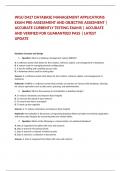Exam (elaborations)
WGU D427 DATABASE MANAGEMENT APPLICATIONS EXAM PRE-ASSESSMENT AND OBJECTIVE ASSESMENT | ACCURATE CURRENTLY TESTING EXAMS | ACCURATE AND VERIFIED FOR GUARANTEED PASS | LATEST UPDATE
- Course
- Institution
WGU D427 DATABASE MANAGEMENT APPLICATIONS EXAM PRE-ASSESSMENT AND OBJECTIVE ASSESMENT | ACCURATE CURRENTLY TESTING EXAMS | ACCURATE AND VERIFIED FOR GUARANTEED PASS | LATEST UPDATE
[Show more]



